| C-82 Packet | |
|---|---|
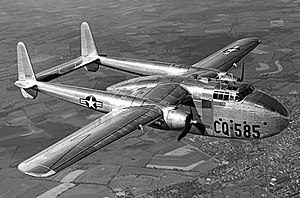 C-82A Packet C-82A Packet | |
| General information | |
| Type | Cargo and troop transport |
| National origin | United States |
| Manufacturer | Fairchild Aircraft |
| Primary user | United States Army Air Forces |
| Number built | 223 |
| History | |
| Manufactured | 1944–1948 |
| First flight | 10 September 1944 |
| Developed into | Fairchild C-119 Flying Boxcar |
The C-82 Packet is a twin-engine, twin-boom cargo aircraft designed and built by Fairchild Aircraft. It was used briefly by the United States Army Air Forces and the successor United States Air Force following World War II.
Design and development
Developed by Fairchild, the C-82 was intended as a heavy-lift cargo aircraft to succeed prewar civilian designs like the Curtiss C-46 Commando and Douglas C-47 Dakota using non-critical materials in its construction, primarily plywood and steel, so as not to compete with the production of combat aircraft. However, by early 1943 changes in specifications resulted in plans for an all-metal aircraft. The aircraft was designed for a number of roles, including cargo carrier, troop transport, parachute drop, medical evacuation, and glider towing. It featured a rear-loading ramp with wide doors and an empennage set 14 feet (4.3 m) off the ground that permitted trucks and trailers to back up to the doors without obstruction. The single prototype first flew on 10 September 1944. The aircraft were built at the Fairchild factory in Hagerstown, Maryland, with deliveries beginning in 1945 and ending in September 1948.
Problems surfaced almost immediately. The aircraft was found to be underpowered and its airframe inadequate for the heavy lifting it was intended to perform. As a result, the Air Force turned to Fairchild for a solution to the C-82's shortcomings. A redesign was quickly performed under the designation XC-82B, which would overcome all of the C-82A's initial problems.
Operational history





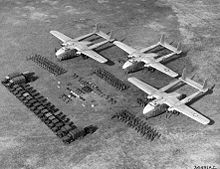
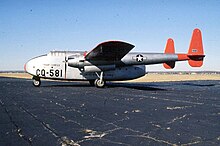
The C-82A was first flown in 1944, with its initial delivery not until June 1945; as a result, only a few entered service before the end of the war. In the end, only 223 C-82As would be built, a small number relative to other wartime production cargo aircraft. Most were used for cargo and troop transport, although a few were deployed for paratroop operations or towing military gliders. A redesign rectifying the aircraft's main deficiencies, made its debut in 1947. Its subsequent improved design would result in the 1949 rollout of the Fairchild C-119 Flying Boxcar.
In 1946, the United States Postal Service explored the concept of flying post offices using highly modified C-82s, which would operate similarly to those on trains where mail would be sorted by clerks and put in bags and then transferred to trucks on landing.
In 1948, a C-82 was fitted with track-gear landing gear, similar to the tracks on a crawler tractor, that allowed landings on unpaved, primitive runways.
During the Berlin Blockade, five C-82 aircraft carried large disassembled earthmoving equipment into the city to enable the construction of Berlin Tegel Airport in the fall of 1948.
Though relatively unsuccessful, the C-82A is best considered as an early development stage of the much more successful C-119B Flying Boxcar. The C-82A saw limited production before being replaced by the Flying Boxcar.
The C-82 was retired from the United States Air Force inventory in 1954.
Civil airline operations
After the C-82A became surplus to United States Air Force requirements, small numbers were sold to civilian operators in Brazil, Chile, Mexico and the United States and these were utilized for many years as rugged freight aircraft, capable of carrying bulky items of cargo. The last example was retired in the late 1980s.
Variants
- XC-82
- Prototype, one built.
- C-82A Packet
- Initial production version, 220 built.
- EC-82A
- 1948, fitted with Firestone-designed tracked landing gear. 13 aircraft allocated for conversion from C-82A, but only one completed.
- XC-82B
- 1947, fitted with 2650hp Pratt & Whitney R-4360 Wasp Major radial engines as a precursor to the C-119 series. One converted from a C-82A.
- C-82N
- 1946, Production aircraft built by North American Aviation. Only three were completed, before the remaining 997 were cancelled.
- Steward-Davis Jet-Packet 1600
- 1956, civil conversion of Fairchild C-82A with 1,600 pounds-force (7.1 kN) Westinghouse J30-W turbojet booster engine in pod above upper fuselage. At least three converted.
- Steward-Davis Jet-Packet 3200
- Conversion of Jet-Packet 1600 with two J30-W engines in above-fuselage pod. One converted in 1957.
- Jet-Packet 3400
- Jet-Packet with a 3,250 lbf (14.5 kN) Westinghouse J34-WE-34, or 3,400 lbf (15 kN) Westinghouse J34-WE-36 booster engine. At least four converted from 1962.
- Steward-Davis Jet-Packet II
- Airframe weight reduction program to increase cargo weights and increased power from Pratt & Whitney R-2800CB-16 engines. Application applied to at least three Jet-Packet 1600s or 3400s, including the TWA C-82A Ontos.
- Steward-Davis Skytruck I
- 1964, C-82A aircraft with 60,000 lb (27,000 kg) takeoff weight, improved performance and a hot-air de-icing system, one converted. The Skytruck brand-name was allegedly the inspiration for Elleston Trevor's Skytruck in the 1964 novel, The Flight of the Phoenix.
- Steward-Davis Skypallet
- 1965 A C-82A redesign with the fuselage floor separating from the aircraft from nose to tail for large cargoes and the installation of an internal hoist. Only one aircraft was converted.
Operators

 Brazil
Brazil
- Brazilian Air Force — the Primeiro Grupo de Transporte de Tropa (1st Troop Transport Group) operated C-82s of 1956-1969
- Serviços Aéreos Cruzeiro do Sul
 Chile
Chile
- Linea Aerea Taxpa Ltda
 Mexico
Mexico
 United States
United States
- Interior Airways
- Trans World Airlines — Used for transporting replacement engines
- United States Army Air Forces
Surviving aircraft
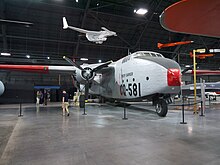

- Brazil
- 45-57783 – C-82A stored at Eduardo Gomes International Airport in Manaus. The aircraft is in poor condition.
- 48-0585 – C-82A stored at the Museu Aeroespacial at Campo dos Afonsos in Rio de Janeiro. It is an ex-Brazilian Air Force aircraft.
- United States
- 44-22991 – C-82A fuselage only in storage in the Walter Soplata Collection in Newbury Center, Ohio.
- 44-23006 – C-82A on static display at the Pima Air & Space Museum in Tucson, Arizona.
- 45-57814 – C-82A on static display at the Hagerstown Aviation Museum in Hagerstown, Maryland. The aircraft was flown to the airport on 15 October 2006, marking the world's last flight of a C-82.
- 48-0574 – C-82A on static display at the McChord Air Museum at McChord Field in Tacoma, Washington.
- 48-0581 – C-82A on static display at the National Museum of the United States Air Force at Wright-Patterson Air Force Base near Dayton, Ohio.
Specifications (C-82A)
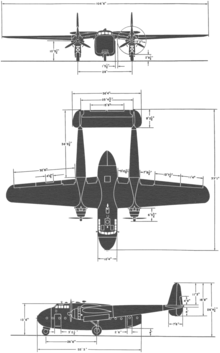
Data from United States Military Aircraft since 1909 & American Military Transport Aircraft Since 1925
General characteristics
- Crew: three
- Capacity: 42 troops or 34 stretchers or 18,000 lb (8.16 t) cargo
- Length: 77 ft 1 in (23.50 m)
- Wingspan: 106 ft 5+1⁄2 in (32.45 m)
- Height: 26 ft 4 in (8.03 m)
- Wing area: 1,400 sq ft (130.1 m)
- Empty weight: 32,500 lb (14,742 kg)
- Gross weight: 50,000 lb (22,680 kg)
- Max takeoff weight: 54,000 lb (24,494 kg)
- Fuel capacity: 2,600 US gal (2,200 imp gal; 9,800 L)
- Powerplant: 2 × Pratt & Whitney R-2800-85 18-cylinder, two-row radial engines, 2,100 hp (1,600 kW) each
- Propellers: 3-bladed Hamilton Standard Hydromatic, 15 ft 2 in (4.62 m) diameter
Performance
- Maximum speed: 248 mph (399 km/h, 216 kn) at 17,500 ft (5,300 m)
- Cruise speed: 218 mph (351 km/h, 189 kn) at 10,000 ft (3,050 m)
- Stall speed: 85 mph (137 km/h, 74 kn) with full flaps
- Range: 3,875 mi (6,236 km, 3,367 nmi)
- Service ceiling: 21,200 ft (6,500 m)
- Rate of climb: 950 ft/min (4.8 m/s)
- Takeoff distance to 50 ft (15m): 1,100 yd (3,300 ft; 1,000 m)
- Landing distance from 50 ft (15 m): 625 yd (1,875 ft; 572 m)
Popular culture
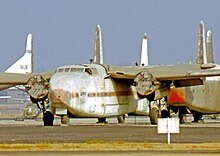
The C-82 is perhaps best known for its role in the 1964 novel, The Flight of the Phoenix, and Robert Aldrich's original 1965 film version. Based on the novel by Elleston Trevor, the story features a C-82A Packet operated by the fictional Arabco Oil Company. It crashes in the Libyan desert, and is rebuilt by the passengers and crew, using one tail boom, and is then flown to safety. Such an aircraft was made for the movie, the Tallmantz Phoenix P-1. It was certified airworthy by the Federal Aviation Administration. Paul Mantz, possibly the greatest Hollywood stunt pilot in history with 25,000 flight hours, was killed with the cameras rolling when he bounced the skids of the craft down too hard in a touch-and-go, buckling and breaking the fuselage behind the wing, sending the craft nose-down hard into the desert, tumbling it completely over at 90 mph. Mantz was killed instantly.
Minor league baseball namesake
In 1953, the local minor league baseball team in Hagerstown, Maryland, was the Hagerstown Braves, so called because they were a minor league affiliate of the major league Milwaukee Braves. The Hagerstown team switched affiliation to the Washington Senators for the 1954 season. Instead of using the major league nickname, they chose the name Hagerstown Packets in tribute to the C-82. The Hagerstown Packets played in the Piedmont League during the 1954 and 1955 seasons.
See also
Related development
Aircraft of comparable role, configuration, and era
References
- Notes
- "Tomorrow's Mail Trains". Popular Science, May 1946.
- Popular Science, August 1948, p. 79.
- "Fairchild C-82A Packet". McChord Air Museum. Retrieved: 24 August 2014.
- ^ "American Airplanes: Fairchild." Aerofiles.com, 11 December 2008. Retrieved: 11 October 2011.
- Beck, Simon. "C-82 Packet." c82packet.com. Retrieved: 31 December 2013.
- ^ "American airplanes: St - Sz: Steward-Davies". Aerofiles.com. Retrieved 31 December 2013.
- Beck, Simon D. (15 November 2017). Fairchild C-82 Packet: The Military and Civil History. McFarland. ISBN 9781476669755.
- "Airframe Dossier - Fairchild C-82A Packet, s/n 45-57783 USAAF, c/n 10153, c/r PP-CEL". Aerial Visuals. AerialVisuals.ca. Retrieved 23 January 2017.
- "Airframe Dossier - FairchildC-82 Packet / C-119 Flying Boxcar, s/n 2202 FABr". Aerial Visuals. AerialVisuals.ca. Retrieved 23 January 2017.
- "Airframe Dossier - FairchildC-82 Packet / C-119 Flying Boxcar, s/n 44-22991 USAAF, c/n 10035". Aerial Visuals. AerialVisuals.ca. Retrieved 23 January 2017.
- "PACKET". Pima Air & Space Museum. Pimaair.org. Archived from the original on 2 February 2017. Retrieved 23 January 2017.
- "1948 Fairchild C-82A Packet "Flying Boxcar"". Hagerstown Aviation Museum. Archived from the original on 13 November 2016. Retrieved 23 January 2017.
- "FAIRCHILD C-82A PACKET". McChord Air Museum. The McChord Air Museum Foundation. Retrieved 23 January 2017.
- "Airframe Dossier& - Fairchild C-82A Packet, s/n 48-0574 USAAF, c/r N4753C". Aerial Visuals. AerialVisuals.ca. Retrieved 23 January 2017.
- "Fairchild C-82 Packet". National Museum of the US Air Force. 7 June 2016. Retrieved 23 January 2017.
- Swanborough and Bowers 1963, p. 265.
- Johnson 2013, p. 142.
- ^ Bridgman 1948, p. 259c
- V, Rob (October 30, 2019). "Hollywood's Stunt Pilots - A Short History of the Earliest Aerial Stuntmen".
- "Packets Selected as Nickname". The Morning Herald. Hagerstown, Maryland. December 23, 1953.
- "Hagerstown, Maryland Minor League History". Baseball-Reference.com. Retrieved November 24, 2014.
- Bibliography
- Bridgman, Leonard. Jane's All the World's Aircraft 1948. London: Sampson Low, Marston & Company, Ltd.
- Johnson, E. R. (2013). American Military Transport Aircraft Since 1925. Jefferson, North Carolina: McFarland & Company, Inc. ISBN 978-0-7864-6269-8.
- Lloyd, Alwyn T. Fairchild C-82 Packet and C-119 Flying Boxcar. Hinckley, UK: Aerofax, 2005. ISBN 1-85780-201-2
- Swanborough, F.G. and Peter M. Bowers. United States Military Aircraft since 1909. London: Putnam, first edition, 1963.
External links
- "Super Size Freighter Resembles P-38 Fighter", Popular Mechanics, March 1944; first illustration of C-82 released to public — bottom half of p. 16
- C-82 packet
| Fairchild aircraft | |||||||||||
|---|---|---|---|---|---|---|---|---|---|---|---|
| Manufacturer designations | |||||||||||
| By role |
| ||||||||||
| Fairchild (Canada) | |||||||||||
| Fairchild-Dornier | |||||||||||
| Fairchild Hiller | |||||||||||
| Fairchild Republic | |||||||||||
| Fairchild Swearingen | |||||||||||
| American Helicopter | |||||||||||
| United States military transport aircraft designations, Army/Air Force and Tri-Service systems | |
|---|---|
| Army/Air Force sequence (1925–1962) |
|
| Tri-service sequence (1962–present) | |
| Revived original sequence (2005–present) | |
| Non-sequential designations | |
| Related designations | |
| Not assigned • Assigned to multiple types • Unconfirmed | |